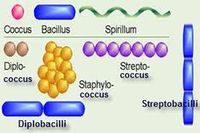Difference between revisions of "Bacteria"
savitanaik (talk | contribs) |
savitanaik (talk | contribs) |
||
| Line 61: | Line 61: | ||
Bacteria are neither plant nor animal. Both bacteria and plants have rigid cell walls, but unlike plants, <br>most kinds of bacteria move about and use organic foods for energy and growth; only a few use photosynthesis.<br> | Bacteria are neither plant nor animal. Both bacteria and plants have rigid cell walls, but unlike plants, <br>most kinds of bacteria move about and use organic foods for energy and growth; only a few use photosynthesis.<br> | ||
On the basis of their shapes,bacteria may be grouped into three main type; | On the basis of their shapes,bacteria may be grouped into three main type; | ||
| + | [[File:Shapes of Bacteria.jpg|200px|left]] | ||
| + | *the rod-shaped bacilli, which often have small whiplike structures known as Flagella that propel the organism; | ||
| + | *the spherical cocci (singular coccus), which may grow in chains (streptococci, or strep germs," <br>as in strep throat) or which may clump together like a bunch of grapes Istrphylococci); | ||
| + | *and the comma or spiral shape spirilla and prirochetes (one of which is the cause of syphilis). <br> | ||
| + | other kind of bacteria, the mycoplasmas, have no rigid cell walls and consequently are called pleuropneumonialike organisms,<br> because they cause a contagious pneumonia in cows and human beings. | ||
===Learning objectives=== | ===Learning objectives=== | ||
Revision as of 07:33, 30 August 2013
| Philosophy of Science |
While creating a resource page, please click here for a resource creation checklist
Concept Map
Error: Mind Map file Bacterias.mm not found
Textbook
To add textbook links, please follow these instructions to: (Click to create the subpage)
Additional information
Useful websites
3.1 Useful websites.:
Reference Books
1. NCERT Text Books.
2. PUC Ist year and 2nd Year Text Books.
Teaching Outlines
Concept Bacteria
1. Habitat and size of Bacteria.
2. Classification of bacteria (based on shapes)
3. Structure of bacteria.
Brief Notes:
Habitat and size of bacteria:
Bacteria (/bækˈtɪəriə/ ( listen); singular: bacterium) are a large domain of prokaryotic microorganisms.
Bacteria are found everywhwere. - even on you !
Approximately 2,000 species have been identified, many of them living in conditions that would destroy other organisms.
They have been found in the almost airless reaches of the upper atmosphere,
10 km (6 mi) below the surface of the ocean, in frozen soil, and on rocks in hot springs.
Some bacteria produce a resting stage, the endospore, which is the most resistant living thing
known and can be killed only by boiling in steam under pressure for many hours.
Size of bacteria:
Thirty trillion bacteria of average size weigh about 28 g (1 oz). Bacteria are measured in microns (0.001 micrometer, about 0.00004 in) and most types range from 0.1 to 4.0 microns in width and 0.2 to 50 microns in length.
2. Classification of bacteria on the basis of shapes:
Content: Teaching Outlines.
Bacteria are neither plant nor animal. Both bacteria and plants have rigid cell walls, but unlike plants,
most kinds of bacteria move about and use organic foods for energy and growth; only a few use photosynthesis.
On the basis of their shapes,bacteria may be grouped into three main type;
*the rod-shaped bacilli, which often have small whiplike structures known as Flagella that propel the organism; *the spherical cocci (singular coccus), which may grow in chains (streptococci, or strep germs,"
as in strep throat) or which may clump together like a bunch of grapes Istrphylococci); *and the comma or spiral shape spirilla and prirochetes (one of which is the cause of syphilis).
other kind of bacteria, the mycoplasmas, have no rigid cell walls and consequently are called pleuropneumonialike organisms,
because they cause a contagious pneumonia in cows and human beings.
Learning objectives
Notes for teachers
Activity No #
- Materials/ Resources needed
- Prerequisites/Instructions, if any
- Multimedia resources
- Website interactives/ links/ simulations
- Process/ Developmental Questions
- Evaluation
- Question Corner
Project Ideas
Fun corner
Usage
Create a new page and type {{subst:Science-Content}} to use this template
